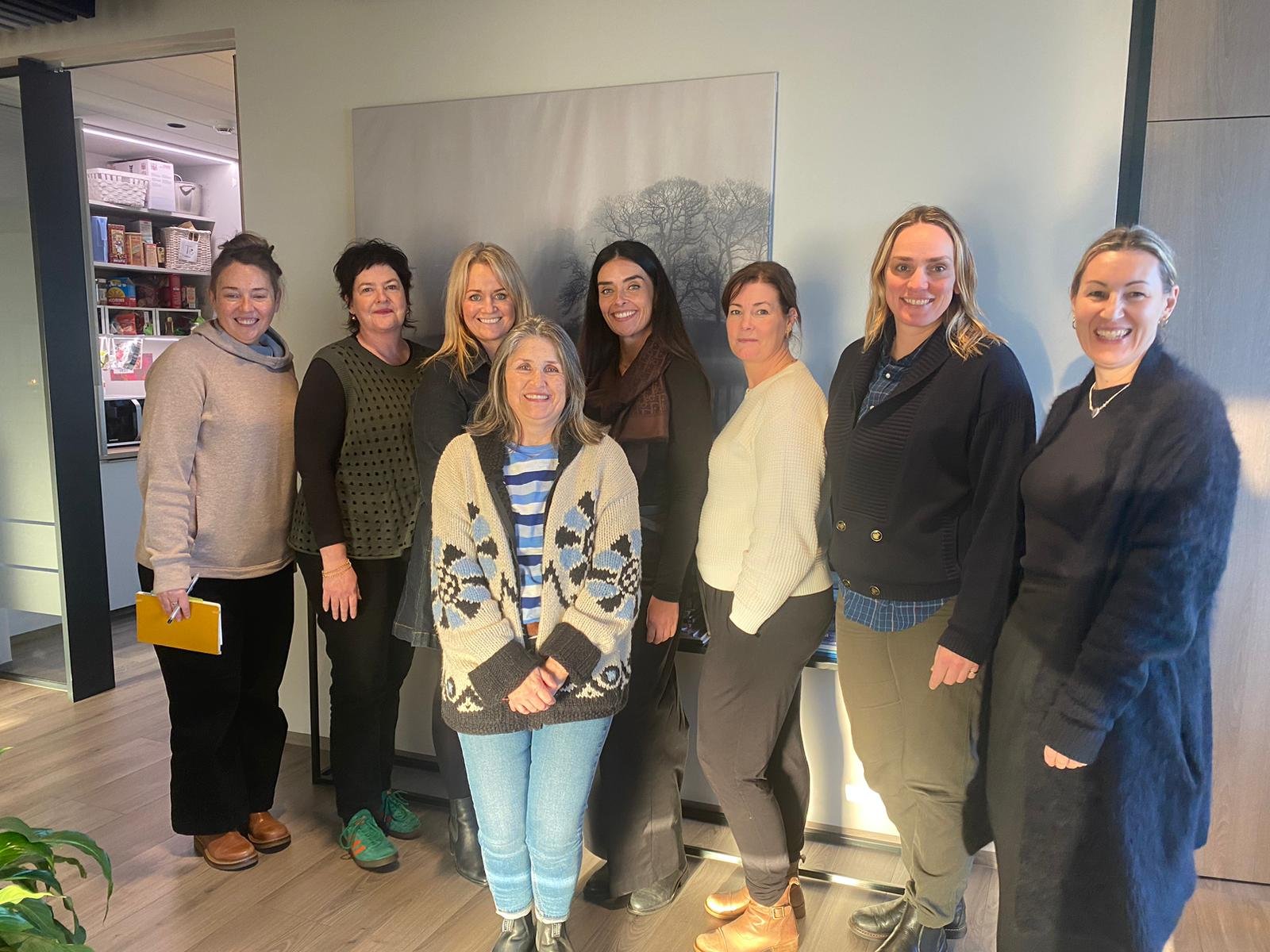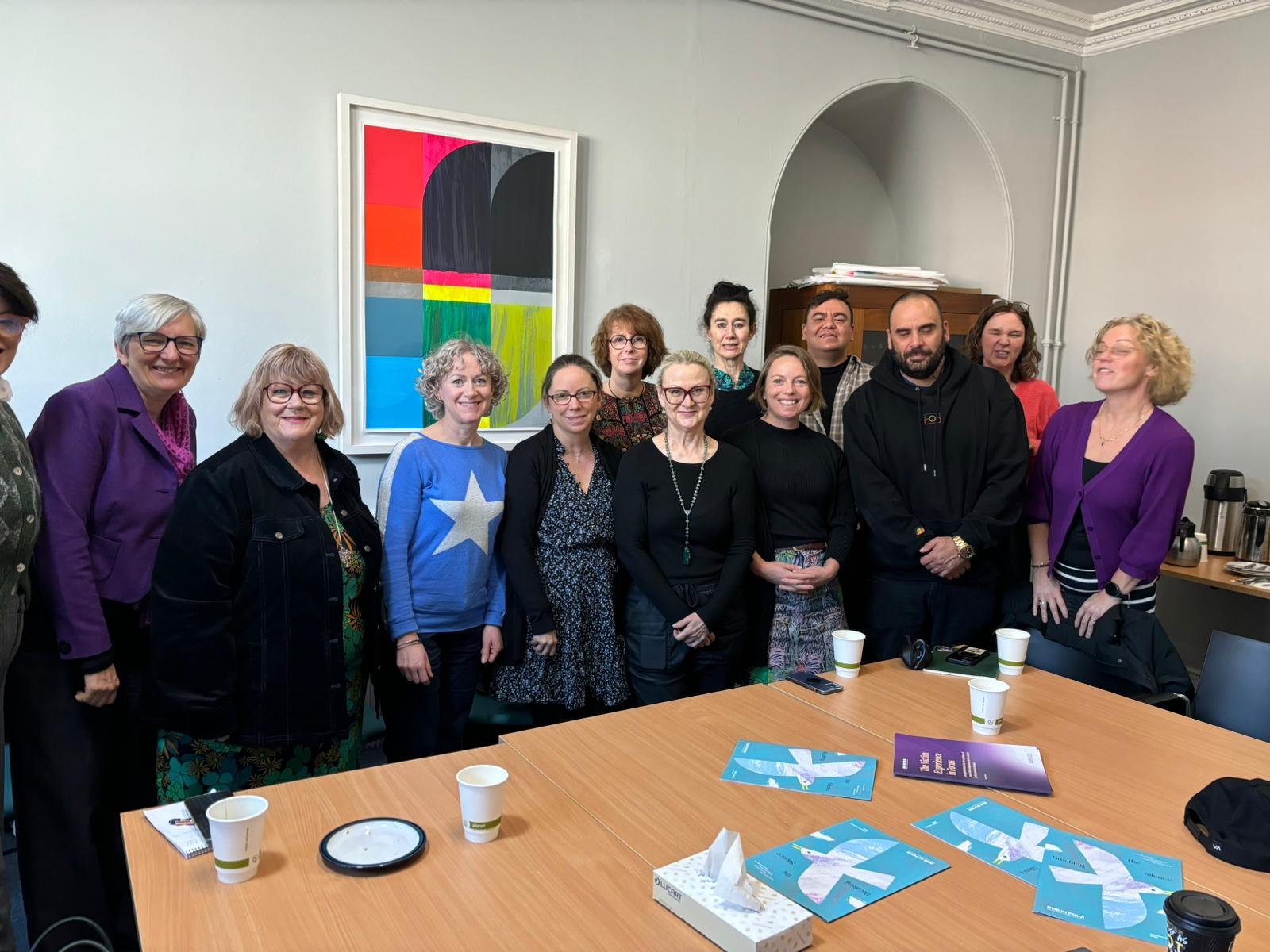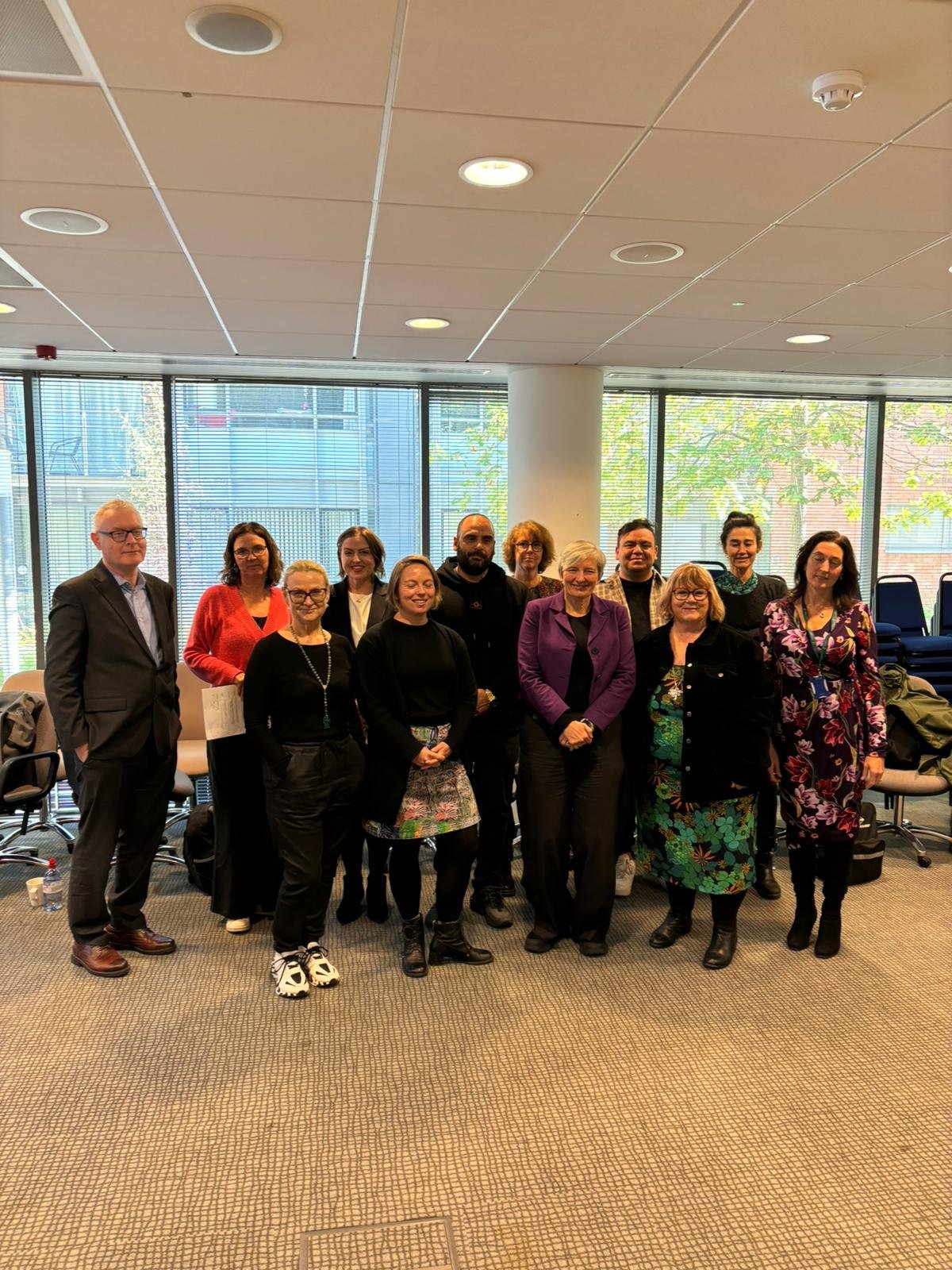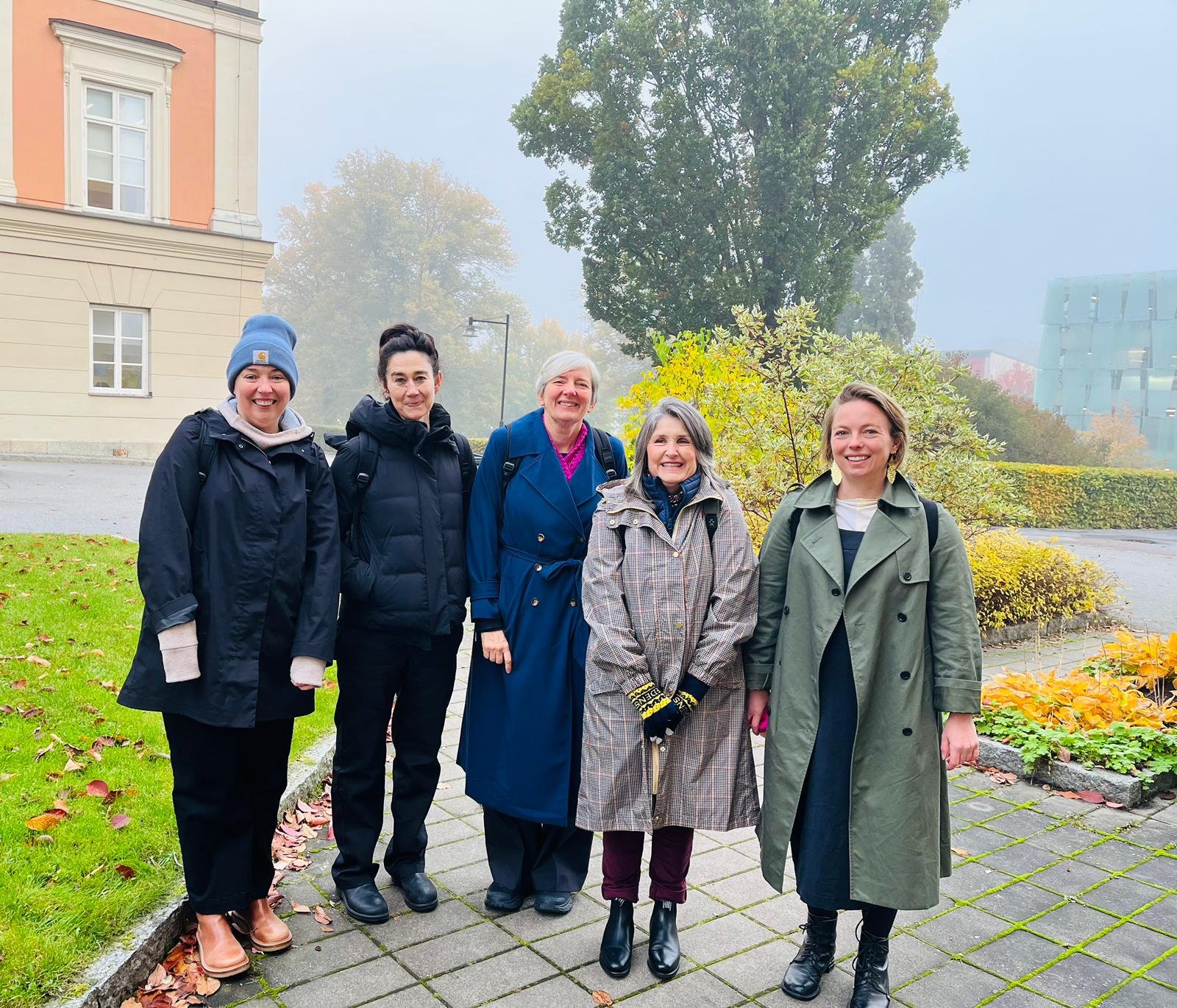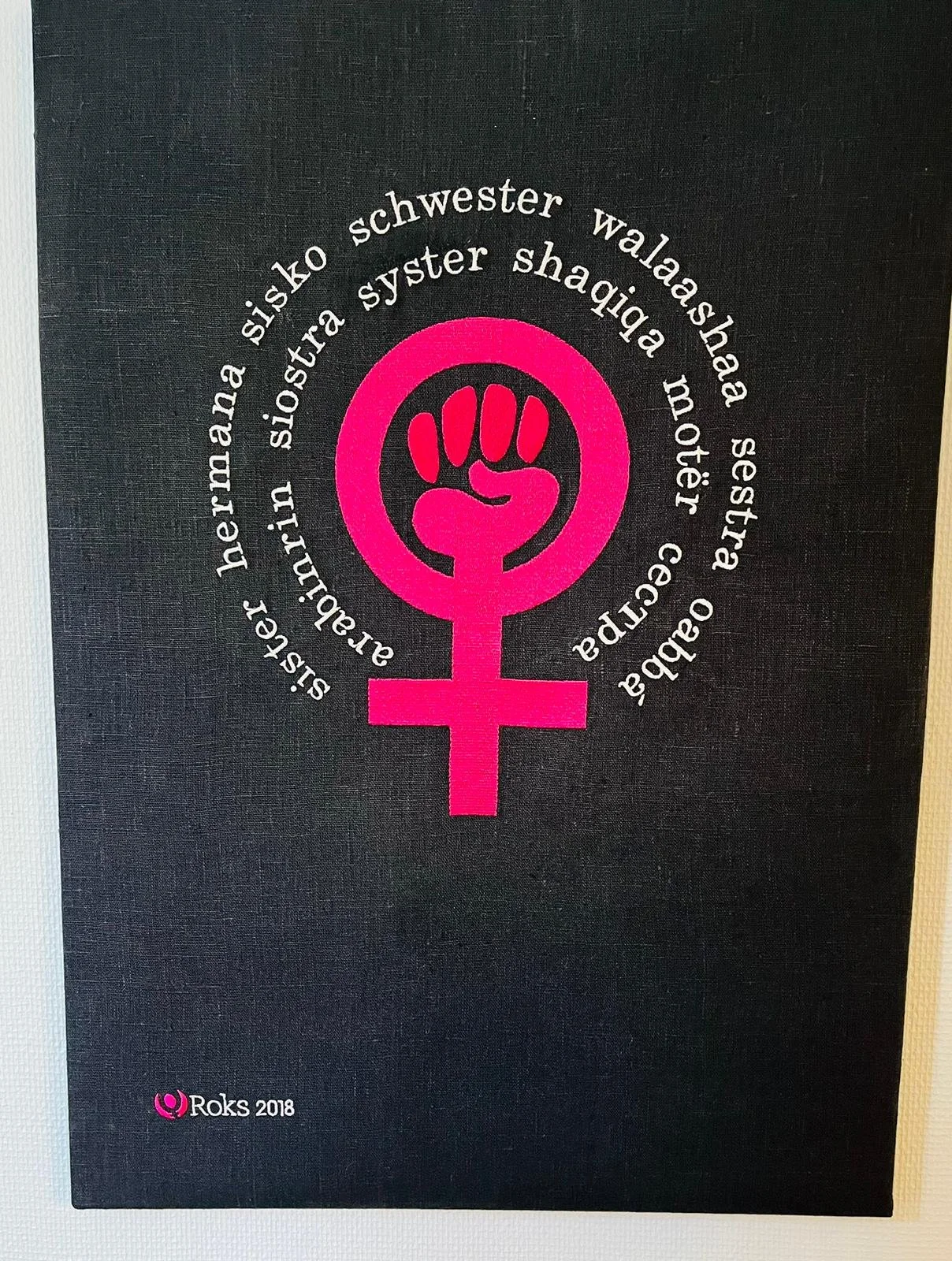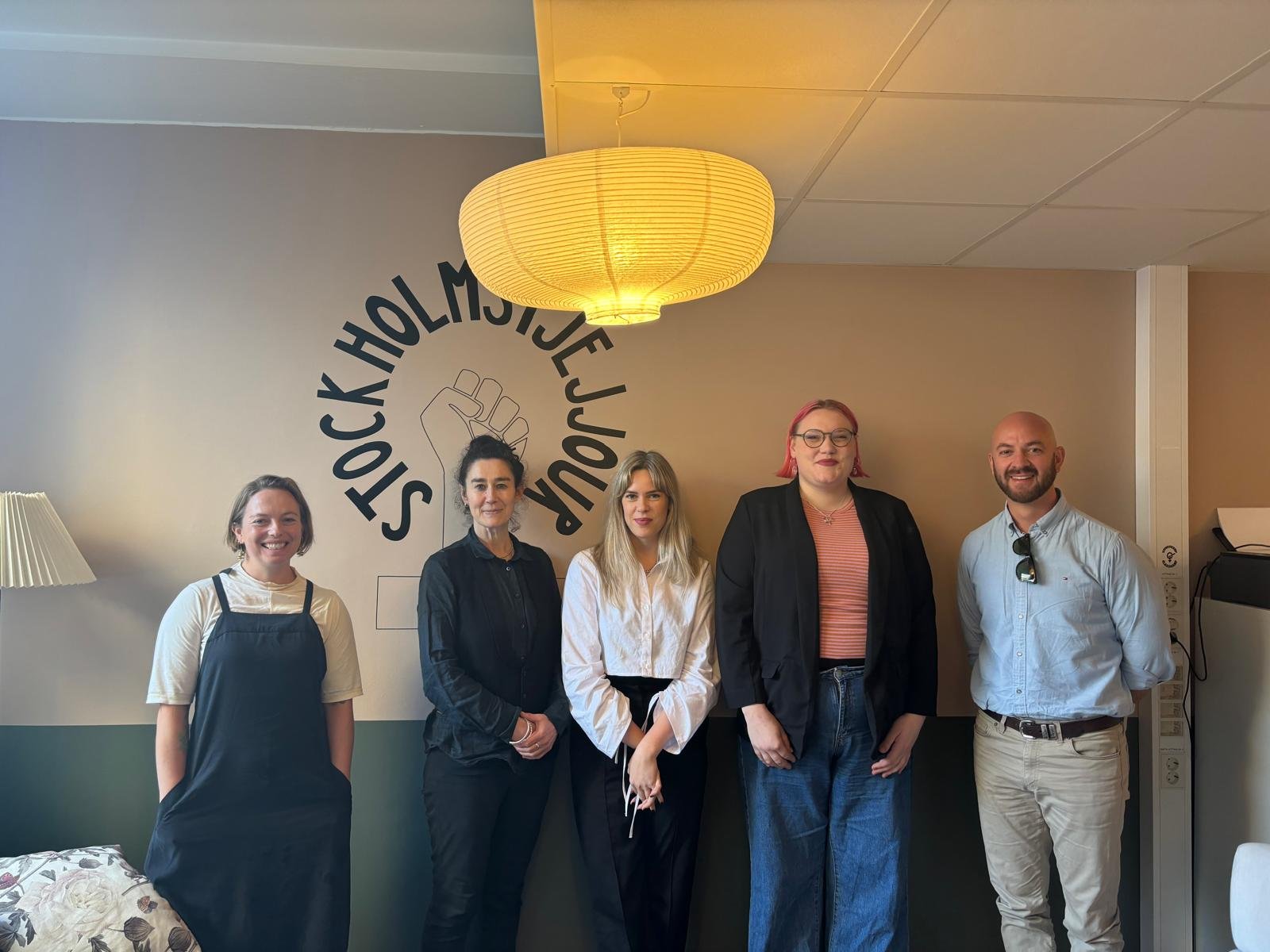Learning from our colleagues overseas: SASVic study tour
On Monday 7 October, SASVic members and other colleagues began an overseas study to learn from specialist sexual violence practitioners and leaders, survivors, academics, government officials, police and others work on sexual violence overseas.
Skip to:
Day 1 (UK - London)
Day 2 (UK - London)
Day 3 (UK - Brighton & Cardiff)
Day 4 (Ireland & Iceland)
Day 5 (Ireland & Iceland)
Day 6 (Sweden)
Day 7 (Sweden)
Day 8 (Belgium)
Day 9 (Belgium)
Day 10 (France)
In anticipation of the tour, Kathleen Maltzahn, SASVic CEO provided her reflections on sexual violence and the obligation to offer the best service we can to help survivors recover.
Just over two years ago, the writer Salman Rushdie, who had lived under the threat of assassination for so long that I suppose many of us had assumed it had evaporated, was attacked, and almost murdered. In his book, Knife: Meditations after an attempted murder, he puzzles over why he didn't try to fight back. Rushdie isn't writing about sexual violence, but on an autumn London day today (more about that below), his words had a particularly resonance for me. This is what he says:
“This is as close to understanding my inaction as I’ve been able to get: the targets of violence experience a crisis in their understanding of the real. Children going to school, a congregation in a synagogue, shoppers in a supermarket, a man on the stage of an amphitheatre are all, so to speak, inhabiting a stable picture of the world...
Violence smashes that picture. Suddenly, they don’t know the rules - what to say, how to behave, what choices to make. They no long know the shape of things. Reality dissolves and is replaced by the incomprehensible. Fear, panic, paralysis take over from rational thought. “Thinking straight” becomes impossible, because in the presence of violence people no longer know what “thinking straight” might be. They - we - become destabilized, even deranged. Our minds no longer know how to work.”
To the list of children, congregations, shoppers, Rushdie himself, we can easily add those about to be raped, groped, exposed. Sexual violence, particular though it is - and it is - is, like other violence, a type of destablisation, as Rushdie says, deranging, disabling in the way it stops us knowing how to work, an undoing. What, then, follows, if we elect not to leave this undoing unattended, if we insist that what has been undone must be allowed to be remade?
For me, the severity of the injury of sexual violence - both its disabling impact, and the moral injury of its injustice - means we need to keep asking ourselves the answers to that question, need to keep grappling with how best to be part of the remaking survivors must do, are entitled to. Those of us working in the funded service system have a particular obligation to make sure what we offer is the best we can, and the best use of our resources.
I am writing from London, where we're just about to start a study tour with 15 participants - SASVic members, colleagues from the Victorian Aboriginal Child and Community Agency (VACCA) and a sexual violence researcher. We'll be travelling across England, Wales, Ireland, Iceland, Sweden, Belgium and France, meeting with specialist sexual violence practitioners and leaders, survivors, academics, government officials, police and others (including those who fit more than one of these categories), trying to learn as much as we can about what's offered in different places, what works, how change has been created and why. We'll also share what we can about what we're doing in Victoria. I'm hoping the experience of seeing other approaches and having space to think and talk with distance from day-to-day demands will help those of us on the study tour to rethink what is possible.
Over the next fortnight, we're aiming for participants to share their reflections on the study tour on LinkedIn and here on our website. We look forward to discussing more with people at home when we return.
Day 1 - Monday 7 October, Child & Women Abuse Studies Unit (CWASU), London Metropolitan University, UK
On Monday, the study tour team met with Professor Liz Kelly, Dr Fiona Vera-Gray and Dr Sukhwant Dhaliwal at CWASU in London.
Here are three key messages from professor of sexualised violence and Director of CWASU, Liz Kelly:
Make more time to think and change how you campaign to create alignment.
Make more time and ways to be radical.
Talk about sexual autonomy - not just protection, risk and vulnerability.
Operation Soteria
We also heard from Prof Liz Kelly, Prof Katrin Hohl (Government Advisor) and Dr Andy Myhill (College of Policing) about justice responses to sexual violence in the UK, including the Police Operation Soteria, a new model that aims to transform the way police respond to rape and sexual offences.
“Launched in June 2021 as Operation Soteria Bluestone within Avon and Somerset Police, it’s aim was to increase the number of adult rape and serious sexual assault cases reaching charge, and, in addition, deliver sustained improvement in the criminal justice whole system response.”
The Operation Soteria framework pushes police to stop trying to second guess what the prosecution or a jury might decide, and instead focus on being 'victim-centred, suspect-focused, context-focused'.
A 2024 progress review of nine forces who adopted Operation Soteria found that half of staff on rape investigation teams were not fully qualified and are still training. The study tour team learned from the experts that the system isn’t engaging with survivors effectively, rather than victims failing to report or pursue sexual violence complaints.
Day 2 - Tuesday 8 October, CWASU, Nia, Women and Girls Network, and Imkaan and Ashiana Network, London.
On Tuesday, the study tour team met with Porfessor Carlene Firmin, Rape Crisis England & Wales (the membership body for specialist sexual assault services), and Cambridge Rape Crisis Service, and then team members went their separate ways to visit:
Nia, an east London rape crisis service and London survivors gateway
Women and Girls Network, a west London rape crisis service and London survivors gateway
Imkaan and Ashiana Network, specialist ‘by and for’ services for Black and minoritised women and children
Independent Sexual Violence Advisors - the inspiration for Justice Navigators
SASVic’s call for Justice Navigators was inspired by Independent Sexual Violence Advisors based at Cambridge Rape Crisis Service and they informed SASVic’s successful campaign to introduce Justice Navigators in Victoria. It was a great joy to meet real-life ISVAs in person today and hear directly about their amazing work.
One takeaway was that we should be striving to celebrate being unpopular because of the work we do.
If Justice Navaigators are to work within a complex and punitive system, they must push back against the hostility of the system to support survivors effectively.
Contextual Safeguarding
Professor Carlene Firmin designed and used Contextual Safeguarding as a theoretical and operational framework to draw attention to, and address, the social and cultural contexts in which extra-familial abuse occurs. Some key messages from Carlene, included:
Stop problematising children and families and start addressing the context around them, including in child protection frameworks.
Everyone has a role to play in creating safe spaces and safe communities around young people including community organisations, shopkeepers and even the local chicken shops.
Day 3 - Wednesday 9 October, Survivors' Network, RISE, Brighton
On Wednesday, half the team made their way to Brighton, where we visited the Survivors' Network, RISE and attended a roundtable with service provides, government officials and police.
Survivors’ Network
In Brighton, we met with the Survivors’ Network, a specialist sexual assault service, who told us about their ISVAs and ChISVAs - Independent Sexual Violence Advisors and Children's Independent Sexual Violence Advisor. There are over 1,000 ISVAs in the UK, and they are part of the inspiration for the new Justice Navigator roles that will be trialled in Victoria. At the Survivors’ Network, as well as generalist ISVA roles, they (like other SV services across the UK) have what they call specialist ISVAs, with a focus on survivors less likely to report to the police, including in their case, people who have experienced racism, men and people with multiple and complex needs. They also have an ISVA for survivors of sexual abuse in the Church of England. We're learning all we can to inform the development of Justice Navigators.
RISE
We then met with RISE, which works on domestic abuse (as it's called here). Like so many organisations we've met so far, RISE runs lots of groups, including one for girls. We mentioned that survivors told us through our REACH research that they wanted to do nature-based activities and advocacy (among other things) - this video captures girls talking about one of RISE's nature based groups.
Survivors also told RISE they want to do activism - RISE used an assets-based community development approach, and developed their Community Connector program, working with survivors to develop solutions to issues they saw in their communities.
Learn more about the Community Connector Program
Victims Rights Review
Later in the day, we attended a roundtable with a group of service providers, government officials and police. We learned that in the UK, there's a process called a Victims Rights Review, where a survivor or an ISVA can ask police to review a decision in a rape and serious sexual offences case, which the police are then required to do.
Day 3 - Wednesday 9 October, Public Health Wales, Safer Wales, Welsh Women’s Aid, Cardiff
On Day 3, the other half of the team made their way to Cardiff where we met with Public Health Wales, Safe Wales and Welsh Women's Aid.
Public Health Wales
The first stop on the tour was to Public Health Wales to discuss opportunities to strengthen prevention and responses to sexual violence with the Welsh Police Commissioner and Commissioner for Older People. We heard about their blueprint for a shared values commitment across all areas of government and service provision, and the need to step up across the community.
Safer Wales
Next up was Safer Wales, which works with victim survivors of domestic violence, rape, sexual abuse, exploitation and hate crime. We met with Bernadette from Safer Wales who provided us with an overview of the StreetLife project. The project works with women at risk of violence and exploitation, providing outreach and intensive support. We heard about how it was initiated around the safety of women and to combat the targeting of sex workers and women from diverse communities by police. We also spoke about how competitive tendering takes time, resources and energy away from doing important work.
Welsh Women's Aid
We then spoke with Welsh Women's Aid, a membership organisation working to end domestic abuse and all forms of violence against women. We heard from them about their drop-in centres that provide washing facilitates and parole services located onsite. They spoke about working with women where they are at and offering unconditional support.
Day 4 - Thursday 10 October, Dublin Rape Crisis Centre, Dublin, Ireland
On Thursday, half of the team visited Dublin Rape Crisis Centre for a site tour and a roundtable meeting with specialist services and membership agencies.
There's a lot that we have in common with organisations we're meeting with on the tour, but today in Dublin some of the differences were both striking and intriguing:
Here, as in the UK and Ireland, volunteers are core to service delivery – Dublin Rape Crisis Centre has sixty volunteers, who enable them to run their helpline, among other things. Volunteers receive high-quality intensive training, do three months of probation, and commit to 2 years volunteering.
International, particularly European, human rights instruments are front and centre, including the Istanbul Convention, a Council of Europe Convention on preventing and combating violence against women and domestic violence.
While in Australia, we tend to talk about family violence and sexual violence, the organisations we’ve met with in England and Ireland also focus on female genital mutilation, child sexual exploitation, trafficking and other violence in the sex industry, captured by the term VAWG (violence against women and girls) that is commonly used. Overall, there is also a much stronger focus on the sex industry as a site of sexual and other violence, with Ireland having criminalised the buying of sexual services.
We met with the Dublin Rape Crisis Centre (who generously hosted us), Rape Crisis Network Ireland, Women’s Aid, the National Women’s Council of Ireland and One in Four.
Day 4 - Thursday 10 October, Stígamót, Reykjavik
The other half of our team arrived in icy Iceland that afternoon and headed to Icelandic specialist sexual assault service Stígamót to meet with Svandis, Anna and Erva in their beautiful office in Reykjavik. It was such a privilege to hear about their incredible service providing counselling, groups and an anonymous online chat for young people.
Some of the key messages we heard included:
It is valuable to offer welcoming and inviting non-clinical spaces without obvious therapeutic or clinical tools.
It is important to be clear and confident in the scope, value and purpose of sexual violence counselling and what is and isn't their work: "We provide counselling not therapy", "on average our clients receive fewer than 5 sessions", "when it stops being about the impact of sexual violence, it stops being our work."
Leading the world in gender equality has not significantly reduced rates of sexual violence.
To engage young people in consent education it's important to leverage the spaces young people want to go in order to learn from them.
The service has been able to add value after-hours through an anonymous online chat.
Staff noted that the service has to rely on fundraising to raise funds for essential services to the community. They are funded 50:50 with government funding and fundraising.
Day 5 - Friday 11 October, One in Four, Ruhama Dublin, Ireland
SASVic and One in Four
On Friday, our group in Dublin met with One In Four, which works on child sexual abuse, attended a roundtable with over twenty public servants working on tackling and reducing domestic, sexual and gender-based violence, hosted by Ireland’s new statutory agency Cuan (similar to Victorian’s Family Safety Victoria), and we visited Ruhama, where we heard both from Ruhama CEO and staff, and the Sexual Exploitation Research and Policy Institute.
One in Four works with both adult survivors and perpetrators of child sexual abuse, and they also run groups for families of both. They gave us a sneak peak of new research they’re doing that seeks to understand what the barriers are to action on child sexual abuse, and talked us through their model for working intensively with sex offenders who have acknowledged their violence.
Roundtable on tackling and reducing domestic, sexual and gender-based violenced, hosted by Cuan.
Cuan and other government representatives referenced the importance of the Istanbul Convention, and their pride in the Irish government’s response to what they call Domestic, Sexual and Gender-Based Violence (DSGBV) was clear; Ireland now has the highest funding to DSGBV services they’ve ever had.
At Ruhama we learned that Ireland has a National Action Plan on Preventing and Combatting Human Trafficking and learned more about the legal status of the sex industry in Ireland, which is very different from the Victorian approach – their Third National Strategy on Domestic, Sexual and Gender-Based Violence, for example, says that ‘research on sex trade and its harms shows that prostitution is seriously detrimental to women’s sexual, reproductive and mental health and wellbeing’. Ruhama has a comprehensive service model, offering women who have been trafficked and others in the sex industry a wide range of services. They work with people from over 50 countries around the world. When we met with them, they had just won a prestigious national award for their work.
One of the themes today – and across our first week – has been how much group work is offered in Ireland and the UK. They’re much more common than in the Victorian sexual assault sector, and we’re inspired by the range and depth of what is offered. Ruhama, for example, has a group program for survivors who are also grappling with drug and alcohol issues and mental illness that they say participants who have been failed by other approaches love, and One in Four has a wide range of groups for survivors, perpetrators and their families. As with other days, we heard more about volunteering; both One in Four and Ruhama have clear roles for volunteers.
Poster in London
We’ve been talking here about some of the differences between Victoria and the places we’re visiting, but one thing we’re hearing about consistently that resonates with our experience at home is the impact of pornography and tech-facilitated sexual violence.
Finally, we liked this poster in London – clear comms at a very busy train station about FV that got to the guts of the matter.
Day 5 - Friday 11 October, Barnahus, Bjarkarhlíð, Ministry of Social Affairs and Labour, Iceland
Court room for forensic interviews at Barnahus
It was a busy day for the Iceland group, visiting 3 services in one day. Our first stop was Barnahus. ‘Barnahus’ is Icelandic for ‘children’s house’ and operates as a child-friendly service, where law enforcement, criminal justice, child protective services, and medical and therapeutic clinicians work collaboratively under one roof to assess the needs of the child. The Barnahus model is now used across the Nordic countries. Barnahus, Reykjavik was established 26 years ago and is based on the model develop in Alabama USA. Services address sexual abuse, physical abuse, family violence and unaccompanied minors who may have been subject to child sexual exploitation and human trafficking.
A variety of assessments are completed by clinicians at Barnahus, including investigative interviews, exploratory interviews, medical examinations (not for forensic purposes), survivor assessments and counselling, family counselling and support and consultations to other services. We were impressed by how the child remained central. Forensic interviews are completed by Barnahus clinicians with law enforcement, criminal justice parties and magistrate, child protection and at times the Director of Immigration, all can be present observing the interview through a one-way mirror with the clinician wearing an earpiece and questions from services interwoven as part of the forensic interview. The child/young person is aware of the process.
Recently a new incentive is being trialled at Barnahus called CPC (combined parent child) - CBT for cases where family violence has occurred, and child protection services assess that the child can remain in the home with the perpetrator. Reparative work is done with the entire family aimed at allowing the family unit to remain together. The offending parent and the child each have their own clinician with a joint session completed following individual sessions. This model is new to Barnahus and is based on the work of Melissa Runyon.
As with the previous days visits the highlights for the group was the clarity of roles and service provision, the client remains central to work completed and the tranquillity and ambience of the environment in which the service is delivered.
The team at Bjarkarhlíð
Following a 20-minute stroll across the Reykjavik parklands, the second visit of the day was to Bjarkarhlíð Adult SASFV service. This agency provides therapeutic support to survivors of sexual assault and family violence. On arriving we were met by Luna the therapy dog. Takeaways from this service included:
Any survivor that attends the centre can have their contact number highlighted so if the police are required following an incident of family violence, their survivors contact number is prioritised for a police response.
Police can write to alleged perpetrators of family violence informing them of a report having been made naming them as a perpetrator. This is especially validating forsurvivors unable to proceed with criminal proceedings due to the statute of limitations.
Our third and final visit of the day was to the Ministry of Social Affairs and Labour where we met with Special Advisor Ministry of Social Affairs and Labour, Sunna Dioriksdottir, who spoke about Iceland’s preventative plan to address gender-based violence and harassment amongst children and young people for 2021-2025. The plan is based on Iceland’s commitment to eradicating violence against women and children.
The vision for Iceland is that sexual and gender-based violence should not occur and that each primary school have a prevention team to ensure the school has relevant education materials for all school stages, teachers are aware of what action they should take within the classroom to discuss the topics required, and everyone who works with children and young people will complete the relevant online training course. The measurement for the success of the program is that 90% of people working with children will complete the online course.
Despite Iceland being at the forefront of gender equality for the last 14 years, gender-based violence remains an issue. Iceland has a National Action Plan for the handling of sexual violence 2023-2025, with 5 key features being emphasised for requiring immediate action, including a reduction in procedural times and better procedural experiences.
Day 6 - Monday 14 October, Barnahus and Barnafrid, Stockholm, Sweden
Today we paid a visit to another Barnahus, this time in Stockholm. The service was situated in Heleneborgsgatan and overlooked the Harbour where many houseboats were docked.
You may have noticed that Barnahus is the same name as the service we visited in Iceland. Barnahus is an Icelandic word meaning ‘children’s house’ and its multidisciplinary model is used across the Nordic countries.
Entering the building we were delighted to follow steps laid out on the floor to help children navigate the different rooms, including the waiting room, police room and social services room. We met with Emma, who is the coordinator from Social Services; Jacob, a psychiatrist; David, a paediatrician, and Jacob from the police.
There are seven coordinators, four crisis counsellors and 80 police offers (this includes investigators and administration staff, four nurses, four doctors, three public prosecutors, 20 officers and six psychiatrists).
This Barnahus is the biggest in Sweden and serves around 1.2 million people. They have around 1,200 children that pass through the doors each year. Their mantra is that they always have the best interest of the children. In each room, there is a map illustrating the journey that a child may expect when they enter. It describes the rooms the child will move through and people they will meet, what to expect and how the people all work together to support the child. They cite the CRC (Conventions in Swedish Law – Article 3: the most important is the best interests of the child, and Article 12: the child has the right to express themselves and be heard). They expect that when a child leaves Barnahus, they should be better off than when they entered.
The Barnahuses in Sweden are all developed differently depending on local conditions and are funded by taxpayers’ money.
Feet on the floor help children navigate the Barnahus in Stockholm.
A typical case will look like this:
1. A child tells someone they trust about the abuse
2. Social services calls and consults the coordinator
3. A police report is sent to Barnahus
4. A multi-disciplinary team meeting takes place
5. A child forensic interview is conducted and recorded by specially trained staff
6. Professionals listen from monitor room
7. The forensic medical examination is carried out
8. Crisis support becomes available
They believe the success of this model relies on total collaboration between all teams. They believe the child should be in charge, and they show them the rooms when they enter. There is a policy of no uniforms in the building, which means the children are not traumatised by any past experience of people in uniforms.
There is support available afterwards – this could be an information meeting with parents, a home visit, a follow up or feedback given.
The other aspect we were impressed with was the police’s role in helping children, sometimes years down the track, to understand why the people who had harmed them were not put in prison (legal processes).
In the afternoon we met with Ana and Sofia from Barnafrid, which is a national knowledge centre on violence against children.
Anna and Sofia are both analysts and Anna previously worked for a Barnahus. They believe violence is a both a public health issue and a human rights issue. This issue is an uncontroversial political issue and all parties are in agreement.
Their main work consists of:
collecting and disseminating information about violence against children
practising interdisciplinary research
promoting interaction and cooperation between authorities
carrying out assignments for government offices including the Ministry of Social Affairs, Education and research and Employment
work for Linkoping University.
Other activities can include training, lectures, webinars, conferences and publications.
Barnafrid also provide eLearning opportunities on violence against children for all professionals in schools, preschools, municipalities and associations, and to volunteers.
Presentation from Barnafrid, Stockholm
They are currently working on a joint project with Finland and Germany to provide guidelines for Barnahus across the country.
Another project is their web education portal. It follows the case of Hugo, who can access each room and can gain information on
child friendly justice
trauma informed care
multidisciplinary meetings
forensic interviews
medical and mental support
crisis support
children’s reliability and credulity
resources designed for children and young people (to be translated to English in time) that support their understanding of trauma.
Key messages from both services:
working together is very important
have clear and transparent arrangements with each other
respect the knowledge and the legislation in place
always have the best interests of the child.
Day 6 - Monday 14 October, National Centre for Knowledge on Men’s Violence against Women, National Organisation for Women’s Shelters and Young Women’s Shelters, Uppsala, Sweden
The team is Uppsala
The other half of the team were also in Sweden where they visited the National Centre for Knowledge on Men’s Violence against Women (NCK). Here, we learned that every doctor in Sweden is is trained to do forensic medical examinations, avoiding the need for a specialist forensic unit to do them and ensuring survivors have relatively easy access to FMEs. Quite a contrast to many parts of Victoria, and, indeed, Australia. Instead, forensic specialists write expert reports based on the results of the forensic medical examinations and any other information available to them. NCK ensures doctors all over the country have a forensic medical examination ‘toolkit’, with everything they need to conduct the test (equipment and a guide) and information about NCK’s helplines - they’ve developed the toolkit in cooperation with the Swedish Police Authority, the National Forensic Centre and the Swedish Prosecution Authority. Tests are kept for up to two years, allowing survivors to have time to decide if they want to report to police.
NCK also runs helplines with separate numbers for men, women, transgender people, and ‘individuals who live with rules and requirements to protect the family’s reputation or honor’. Interestingly, the European Union is working towards having one number across Europe, that diverts to the relevant lines in every local area as needed.
As in other places, our NCK hosts talked about the Istanbul Convention, explaining that it was a very good tool for them.
The team visiting ROKS
National Organisation for Women’s Shelters and Young Women's Shelters (ROKS)
ROKS is the largest member organisation for women's and young women's shelters in Sweden, and aims to safeguard the common interests of the shelters in their work against male violence towards women. While the word used in translation is often shelters or women’s support agencies, our ROKS colleagues, Amanda and chair Camilla, explained that their members are really women’s empowerment centres. Their member centres are solely for women, as their philosophy is that women need space to talk with each other about men’s violence. The centres aim to ensure a low threshold for women to access them so women can be anonymous and don’t have to provide a lot of information to access support.
ROKS is proudly political. They say that:
Feminism is action
They offer sisterhood not paternalism
Feminism provides knowledge
Knowledge drives political change
It was incredibly energising and inspiring just to meet with them.
Day 7 - Tuesday 15 October, Stockholm Tjejjour, Division of Gender Equality, Uppsala, Sweden:
The team at Stockholm Tjejjour
On our last morning in Stockholm, one half the team had the pleasure of meeting with Linn & Emma at Stockholm Tjejjour, an anonymous support line for young women run by peer volunteers.
Linn and Emma told us about the history and strong feminist values of Tjejjour, and emphasised the importance of providing a completely confidential and anonymous support service for young women and girls. "We don't say equality here", explained Emma, "we say feminism."
Each week Tjejjour also provides legal support and support for neurodivergent young women provided by peers with legal training and specialist expertise.
The other half met with the Swedish government’s Division of Gender Equality, who explained that gender equality is a core Swedish value, and that there is cross-party support in parliament for action on gender-based violence. In Sweden, political differences are expressed in terms of how to progress gender equality, not if it should be addressed.
The overall goal of the Swedish gender equality policy is ‘that women and men must have the same power to shape society and their own lives’. One of the six sub-goals of the policy is that ‘men’s violence against women must stop. Interestingly, the government representatives we met with explicitly highlighted the fact that Sweden’s strong women’s movement has contributed to the country’s commitment to gender equality (alongside demand for an increased labour force). Their most recent national strategy for preventing and combatting men’s violence includes a focus on so-called honour-related violence and oppression, children and young people who experience violence, increasing knowledge about the digital dimensions of violence and exit programs for people leaving destructive relationships.
“Whatever it is, the way you tell your story online can make all the difference.”
Day 8 - Wednesday 16 October, Garance, Polish Girls Advisory Group (@ohmy_gag), Brussels, Belgium
The study tour team finally combined to fly to Brussels where they visited Garance, a unique Belgium primary prevention NGO, where Garance International Affairs office and co-founder, Irene Zeilinger, shared a thought-provoking presentation. Garance’s assessment of existing evidence is that large scale awareness raising campaigns are relatively ineffective in driving down gendered violence; the World Health Organisation (WHO) has done a macro study on this. Instead, they offer a wide range of community-based programs, including feminist self-defence, school-based primary prevention programs for school children and by-stander training for men and boys (among many other impressive programs).
Irene explained that feminist self-defence is premised on the philosophy that:
To defend yourself, you have to value yourself
To defend yourself, you have to overcome power inequality and stereotypes
To defend yourself is to reclaim the right to exist and to live without violence.
While there is a myth that that feminist self-defence is a form of victim-blaming, evaluations of self-defence show that this is not so, and that it has a multitude of powerful positive impacts, including that participants’ experience of fear changes in both quality and quantity and that generalised anger decreases and specific anger increases.
Irene contributed to Women Against Violence Europe’s (WAVE) recent publication on prevention – it’s a fascinating contrast to a lot of our approaches to prevention in Australia.
Polish Girls Advisory Group
After our meeting with Garance, we had the real pleasure to meet with Agatha Teutsch, Juniper foundation Board member, and members of the Girls Advisory Group, from Poland. Like at Garance, feminist self-defence is a central part of the work of Agatha and other Polish feminists – she estimates that they have 100,000 women and girls have participated in their feminist self-defence programs, and they have trained 100 trainers, half of whom have a connection to the Ukraine. The three pillars of theirtheir work are strength, courage and solidarity, and ideas around empowerment and emancipation are central to their work, as are intersectionality and accessibility. Members of their Girls Advisory Group spoke in particular about work they are doing to create safer cities for girls.
Day 9 - Thursday 17 October, European Parliament, Brussels, Belgium
On Thursday, the team attended the European Network of Migrant Women conference at European Parliament. We were privileged to listen to inspiring, knowledgeable and passionate presenters. We heard about the intersection of the rule of law, human rights and democracy required for value based policies, and the role that strategic litigation plays in advancing the rights of migrant women in the EU in the FULFIL project.
Emma Rafowicz, a 29 year old member of the European Parliament finished her speech by saying:
“We need you. We need you to be loud. We need you to say equality is a priority. We need you to say that dignity and rights for migrant women all over the world is important. We have a lot of rights to be had, but obviously we will win them all because we are together as feminists.”
Day 10 - Friday 18 October, Council of Europe, Strasbourg, France
Our final day of the study tour was spent at the Council of Europe in Strasbourg, France, learning about the Council of Europe Convention on the Protection of Children Against Sexual Exploitation and Sexual Abuse (called the Lanzarote Convention) and Convention on Preventing and Combatting Violence Against Women and Domestic Violence (the Istanbul Convention). Both conventions are open to be signed by non-European states.
Both conventions are considered the most far-reaching international human rights treaties on these topics, and both are credited with significant improvements in Europe. For example, work around the Lanzarote convention has led to the introduction of the Barnahus model (which we talked about in a previous blog, following our visits to Barnahus centres) across Europe and the Istanbul Convention has driven a legislative shift to the affirmative consent model in many member countries.
Both conventions have monitoring mechanisms, and while they cannot sanction member states, monitoring is driving innovation and improvements, including because the country reports and recommendations generated through the monitoring processes give NGOs and activists opportunities to put pressure on their governments.
Civil society organisations have a formal role in both conventions, allowing NGOs to put pressure on governments to act, and there is also a formal role for survivors’ representatives.
The Council of Europe has declared 18 November the Day for the Protection of Children against Sexual Exploitation and Sexual Abuse: this year’s theme is “Emerging technologies: threats and opportunities for the protection of children against sexual exploitation and sexual abuse”.
Interestingly, Australia is already a signatory to the Council of Europe’s Cybercrimes Convention, which the Lanzarote Convention experts we met with described as closely related to the work of the Lanzarote Convention.
Several of us came away excited about the possibilities that Australia signing on to these two conventions might create.






